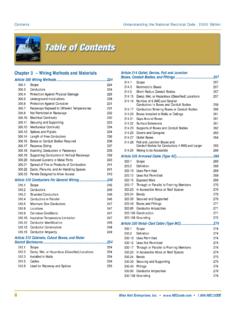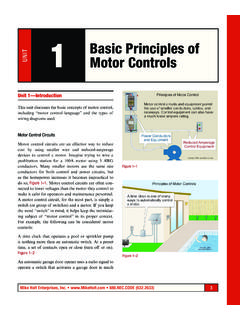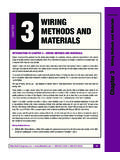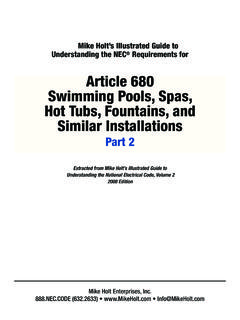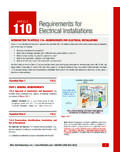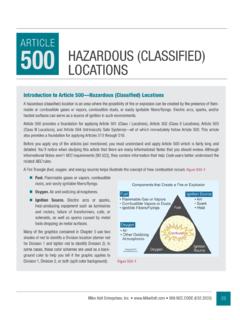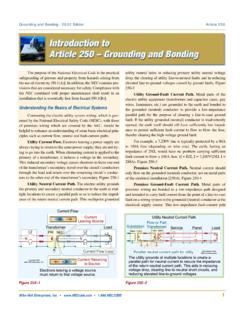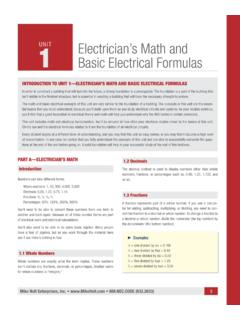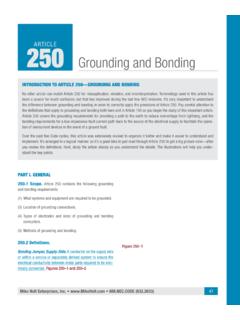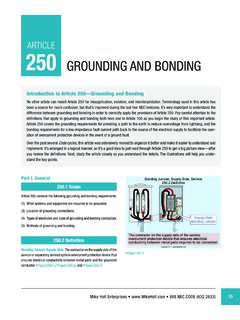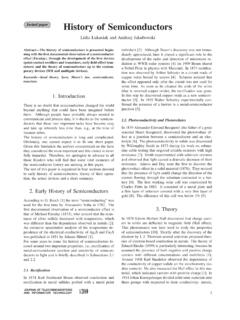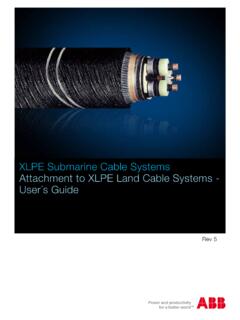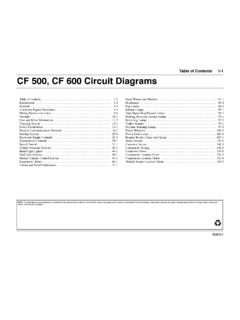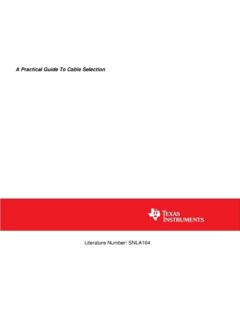Transcription of AC 800 Communications Circuits - Mike Holt Enterprises
1 ARTICLE. 800 communications circuits INTRODUCTION TO ARTICLE 800 communications circuits . This article has its roots in telephone technology. Consequently, it addresses telephone and related systems that use twisted-pair wiring. Here are a few key points to remember about Article 800: Don't attach incoming Communications cables to the service-entrance power mast. It's critical to determine the point of entrance for these Circuits . Ground the primary protector as close as practicable to the point of entrance. Keep the grounding electrode conductor for the primary protector as straight and as short as possible. If you locate Communications cables above a suspended ceiling, route and support them to allow access via ceiling panel removal. Keep these cables separated from lightning protection Circuits . If you install Communications cables in a Chapter 3 raceway, you must do so in conformance with the NEC requirements for the raceway system. Special labeling and marking provisions apply follow them carefully.
2 Note: The term Grounding Conductor previously used in this arti- cle has been replaced by either Bonding Conductor or Grounding Electrode Conductor (GEC) where applicable to more accurately reflect the application and function of the conductor. Figures 800 1 and 800 2. Figure 800 2. Author's Comment: For Articles 800, 810, and 820, the differ- ence between a bonding conductor and a grounding electrode conductor is where they terminate. The bonding conductor ter- Figure 800 1 minates at the intersystem bonding termination; the grounding electrode connects to the power grounding electrode system [ ]. mike holt Enterprises , Inc. ( ) 67. Communications Circuits PART I. GENERAL. Scope. This article covers Circuits that extend voice, audio, video, interactive services, and outside wiring for fire alarms and bur- glar alarms from the Communications utility to the customer's com- munications equipment up to and including equipment such as a telephone, fax machine, or answering machine [ ] and communi- cations equipment.
3 Figure 800 3. Figure 800 4. Communications Raceway. An enclosed channel of nonmetallic materials designed for holding Communications wires and cables in plenum, riser and general-purpose applications. Figure 800 5. Figure 800 3. Note: The NEC installation requirements don't apply to communica- tions utility equipment located outdoors or in building spaces under the exclusive control of the Communications utility [ (B)(4)]. Figure 800 4. Definitions. Abandoned Communications Cable. A Communications cable that isn't terminated to equipment and not identified for future use with a tag. Author's Comment: Section requires the accessible portion of abandoned Communications cables to be removed. Communications circuit . The circuit that extends voice, audio, video, Figure 800 5. interactive services, and outside wiring for fire alarms and burglar alarms from the Communications utility to the customer's communi- cations equipment up to and including terminal equipment such as a Point of Entrance.
4 The point within a building at which the commu- telephone, fax machine, or answering machine. nications cable emerges from an external wall, from a concrete floor slab, or from a rigid metal conduit or an intermediate metal conduit connected in accordance with (B). Figure 800 6. 68 Understanding 2011 NEC Requirements for Limited Energy and Communications Systems Communications Circuits Figure 800 6 Figure 800 7. Installation of Equipment. Communications equip- ment must be listed [ ] and must be installed in accordance with manufacturer's instructions [ (B)]. Access to Electrical Equipment Behind Panels Designed to Allow Access. Access to equipment must not be prohibited by an accumulation of Communications cables that prevent the removal of suspended-ceiling panels. Communica- tions cables must be located so that the suspended-ceiling panels can be moved to provide access to electrical equipment. Mechanical Execution of Work. Equipment and Communications cabling must be installed in a neat and workman- like manner.
5 Exposed Communications cables must be supported by the structural components of the building so that the communica- tions cable won't be damaged by normal building use. Cables must Figure 800 8. be secured with straps, staples, cable ties, hangers, or similar fit- tings designed and installed so as not to damage the Communications Cables installed parallel to framing members or furring strips must be cable. Figure 800 7. protected where they're likely to be penetrated by nails or screws, by Communications raceways and Communications cable assemblies installing the wiring method so it isn't less than 1 in. from the near- must be securely fastened in place and ceiling-support wires or the est edge of the framing member or furring strips, or is protected by a ceiling grid must not be used to support Communications raceways or 1. 16 in. thick steel plate or the equivalent [ (D)]. Figure 800 9. Communications cables [ ]. Figure 800 8. Note 1: Accepted industry practices are described in ANSI/.
6 Author's Comment: Raceways and cables can be supported NECA/BICSI 568, Standard for Installing Commercial Building Telecommunications Cabling and ANSI/NECA/FOA 301, Standard for by independent support wires attached to the suspended ceiling Installing and Testing Fiber Optic Cables. Figure 800 10. in accordance with (A). mike holt Enterprises , Inc. ( ) 69. Communications Circuits Author's Comment: There are no requirements for support hardware to be listed, but NFPA 90A-2009 has heat release and smoke emissions requirements for cable ties in sections ( plenums) and (raised floor plenums). Abandoned Cable. To limit the spread of fire or prod- ucts of combustion within a building, the accessible portion of commu- nications cable that isn't terminated at equipment and not identified for future use with a tag must be removed [ ]. Figure 800 11. Figure 800 9. Figure 800 11. Author's Comment: Cables installed in concealed raceways aren't considered accessible, therefore they're not required to be removed.
7 Cables identified for future use must be with a tag that can withstand the environment involved. Figure 800 12. Spread of Fire or Products of Combustion. Electrical Circuits and equipment must be installed in such a way that Figure 800 10 the spread of fire or products of combustion won't be substantially increased. Openings in fire-rated walls, floors, and ceilings for elec- Author's Comment: For more information about these stan- trical equipment must be firestopped using methods approved by the dards, visit authority having jurisdiction to maintain the fire-resistance rating of the fire-rated assembly. Figure 800 13. Note No. 2: See NFPA 90A-2009, Standard for the Installation of Air- Conditioning and Ventilating Systems, for discrete combustible com- Author's Comment: Firestop material is listed for the specific ponents installed in accordance with (B) and (C). types of wiring methods and construction structures. 70 Understanding 2011 NEC Requirements for Limited Energy and Communications Systems Communications Circuits PART II.
8 CABLES OUTSIDE AND. ENTERING BUILDINGS. Overhead (Aerial) Communications Cables. (B) Above Roofs. Overhead (aerial) Communications cables must have a vertical clearance of at least 8 ft from all points of roofs above which they pass. Ex 1: Auxiliary buildings such as garages. Ex 2: Cable clearance over the roof overhang can be reduced from 8. ft to 18 in. if no more than 6 ft of overhead (aerial) conductors pass over no more than 4 ft of roof and they terminate to a raceway mast or other approved support. Figure 800 12 Underground Communications Wires and Cables Entering Buildings. The requirements that insulated conductors and cables in wet locations be listed for wet locations [ (C) do not apply to Communications cables. Unlisted Cables Entering Buildings. Unlisted Communications cables can be installed in building spaces other than risers, ducts, or plenum spaces as described in (C), if the length of the cable within the building from its point of entrance doesn't exceed 50 ft and the cable terminates in an enclosure or pri- mary protector.]
9 Figure 800 14. Figure 800 13. Note: Directories of electrical construction materials published by qualified testing laboratories contain listing and installation restric- tions necessary to maintain the fire-resistive rating of assemblies. Outlet boxes must have a horizontal separation not less than 24. in. when installed in a fire-rated assembly, unless an outlet box is listed for closer spacing or protected by fire-resistant putty pads in accordance with manufacturer's instructions. Figure 800 14. mike holt Enterprises , Inc. ( ) 71. Communications Circuits Note 2: The primary protector must be located as close as practica- Author's Comment: Selecting a primary protector location to ble to the point at which the cable enters the building [ (B)]. achieve the shortest practicable primary protector bonding con- Therefore, unlisted outside plant Communications cables may not be ductor or grounding electrode conductor [ (A)(4)] helps permitted to enter the building if it's practicable to place the primary protector closer than 50 ft to the point of entrance.
10 Reduce differences in potential between Communications Circuits and other metallic systems during lightning events. Author's Comment: The point of entrance is defined as the point within the building where the cable emerges from an Grounding or Interruption of Metallic Sheath external wall, from a concrete floor slab, or from rigid metal con- Members of Communications Cables. duit or intermediate metal conduit connected to an electrode by a grounding conductor in accordance with [ ]. (A) Entering Buildings. In installations where the Communications cable enters a building, the metallic sheath members of the cable can be grounded as specified in or interrupted by an insu- Lightning Conductors. If feasible, a separation not lating joint or equivalent device as close as practicable to the point of less than 6 ft must be maintained between Communications wiring entrance. Figure 800 16. and lightning protection conductors. Figure 800 15. Figure 800 15 Figure 800 16. PART III. PROTECTION PART IV.
